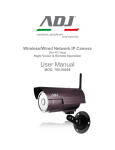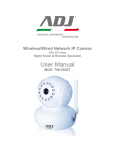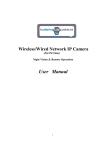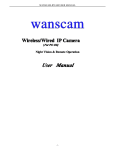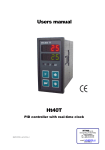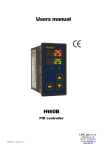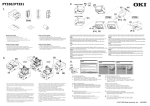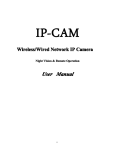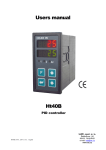Download User Manual
Transcript
User Manual Night Vision & Remote Operation for Wireless Pan & Tilt IP Camera, Model: PT423IP (Applicable for Windows XP, Windows 7 and Windows 8) 0 Packing Contents ● ● ● ● ● ● ● Sineoji IP Camera PT423IP User Manual Power Adapter Mounting Bracket Ethernet cable Software CD Mounting Bracket 1 1. Product Introduction 1.1 Safety Instructions (1). Use the proper power source. Do not use this product with a power source exceeding the specified voltage (100-240V AC). (2). Never insert anything metallic into the camera. Inserting metal object into the camera can be a source of dangerous electric shock. (3). Do not operate in wet or dusty environment. Avoid places like a damp basement or dusty hallway. (4). Do not attempt to disassemble the camera. You may be subjected to severe electrical shock if you attempt to take apart the camera while the camera is connected to its power source. If there are any unusual sounds or smells coming from the camera, unplug it immediately and contact the Customer Service. (5). Handle the camera carefully Dropping the camera on any hard surface may cause a malfunction. If the camera does not work properly due to physical damage, please contact the Customer Service for repair or exchange. (6). Apply to FCC and CE Rule This device complies with part 15 of the FCC and CE Rules. Operation is subject to the following two conditions: 1: This device may not cause harmful interference. 2: This device must accept any interference received, including interference that may cause undesired operation. Any changes or modifications not expressly approved by the party responsible for compliance could void the user’s authority to operate the equipment. This equipment complies with FCC and CE radiation exposure limits set forth for uncontrolled environment. This equipment should be installed and operated with minimum distance 20 cm between the radiator & your body. This transmitter must not be co-located or operating in conjunction with any other antenna or transmitter. 2 1.2. Product Specifications Adopt high Performance, strong function media processor 32Bit RSIC High sensor CMOS Adopt optimized MJPEG video compression algorithm, realize high-definition images transmission in narrow bandwidth; Maximum support 4 users viewing at the same time, no limit for users if using forwarder Server function Built in Web Server, convenient for users to use standard browsing for real time monitoring and setting administration; Support WIFI:802.11 b/g/n wireless networking; Support remote system update; Support DDNS analysis, support LAN & Internet Support variety of network protocol: TCP/IP, UDP, SMTP, PPPoE, Dynamic DNS, DNS Client, SNTP, BOOTP, DHCP, FTP, SNMP, WIFI/802. 11b/g Support one/ two way audio, talkback; Support motion detection alarm function (area & sensitivity Configurable); Support image snapshot Abnormal automatic recovery function, auto reconnection available when network Interruption occurred. Dynamic alarm function, alarm time-schedule configurable. 1.3. System Requirements CPU Memory Network Card Display Card Operating System Internet Explorer DirectX Audio Card Network Protocol : : : : : : : : : 2.06GHZ or above 265M or above 10/100/1000 64M or above Windows XP/Vista/Windows 7/Windows 8 (32 bit) Version 5.0 or above Version 8.0 or above Microphone and speaker output TCP/IP, UDP, SMTP, PPPoE, Dynamic DNS, DNS Client, SNTP,BOOTP, FTP, SNMP, WiFi 802.11 b/g/n 3 1.4. Product Views 1.4.1 Front View Figure 1.1 1.4.2 Rear View Figure 1.2 Audio Out LAN PORT: RJ-45 interface. 4 Antenna: Power input interface: connect direct current 5V Power 1.5 Hardware Installation Follow the steps below to set up your camera hardware. Make sure to follow each step carefully to ensure that the camera operates properly 1. Install the Wi-Fi antenna (For wireless model). 2. Plug the power adaptor into camera 3. Plug the network cable into camera, the other side to the router/switch 4. It takes approx. 30 seconds to boot up the camera, then you will find the IP address from “Search Tool” (Figure: 1.8) 5. When the power is on and the network cable connected, the green led at the real panel will be on; the yellow led will be blinking. Figure 1.3 1.6 Software Installation Figure 1.4 1. Browse the CD content and select “English”. Click on the “Search Tool” 5 2. Software operation 1.1 Search Tool Software 1.1.1 Search the IP address of the camera. Double click the Icon “ ” run this IP address search tool. Figure 2.1 Note: The software searches IP Servers automatically over LAN. There are 2 scenarios: 1. No IP Cameras found within LAN. After about 1 minute search, the Cameras List Field does not show the IP address. 2. IP Cameras have been installed within the LAN. All the IP Cameras will be listed and the total number is displayed in the Cameras list field as shown in Figure 2.1 Note: 1. Current Computer indicates the Computer’s IP Address information. 2. Equipment information indicates the IP camera’s IP Address information. 6 3. If you find that the camera’s “Subnet Mask”, “Gateway”, “DNS Server” does not correspond to your current computer’s values, you need try to change the camera’s IP address. Make sure the “Subnet Mask”, “Gateway”, “DNS Server” is the same as your router or your current computer. 4. If you do not know how to configure your camera’s IP address. You can click “Update” button. The Search Tool software will assist you to configure a usable IP camera automatically. 2.1.2 Configuration of the Network Once your camera’s IP address’ Subnet Mask, Gateway, DNS Server is the same as your PC or router, you need configure the camera’s Network parameter manually. IP address: Fill in the IP address assigned and make sure it is in the same subnet as the Gateway, and the subnet should be the same as your computer or router. (I.e. the first three sections are the same) Subnet Mask: The default subnet mask of the equipment is: 255.255.255.0. You can find the subnet mask from your PC or router. Gateway: Make sure it is in the same subnet with the PC’s IP address. The gateway is the LAN IP of your router. Primary DNS: IP address of ISP network provider. You can also set it as the same as the Gateway. NOTE: You can find out the Subnet Mask, Gateway, Primary DNS of your PC from the “Search Tool” software. Http Port: LAN port assigned for the equipment, default is 99. You can change the port number to any one you want such as: 98,211,9999 etc. 3: Real-time Video Demonstration. 3.1. Camera Login: You can access the camera through IP Camera Tool or IE, Firefox, Safari, Google Chrome or other standard browser directly. 1. Double click the IP address of the IP Camera listed (Figure 2.1). The default browser you use will run automatically and come to the camera login interface. (Figure 3.1) 2. To access the camera by IE Browser directly, just type the camera’s IP address, for example, if the camera’s IP address is 192.168.1.99:99: 7 Figure 3.1 Username: admin Password: NO PASSWORD. Input the correct user name and password, the sign In interface will pop-up. There are three modes to login (figure 3.2). Figure 3.2 (1) ActiveX Mode (For IE Browser): available in IE6.0 or above explorer (2) “RTSP Stream Mode”: available in Firefox, Safari, and Google browser. (3) “No Plug-In Mode”: available in smart phone browser. (4) SD card video playback online 3.2. View via IE Browser. 8 Select Active Mode (For IE Browser), and sign in. The first time when you login to the camera, you may be prompted with an ActiveX script as shown below. Please download the Ocx(or run camera’s live video will not appear. in CD) and install, otherwise, the Figure 3.3 Installing the Ocx-Setup (oPlayer Software), click ”NEXT” until it is completed. 9 Figure 3.4 Figure 3.3 Windows XP system Note: If there is still no live video after running ActiveX, please try to enable the ActiveX options of IE security settings, please do the follow steps: 1. Close the firewall of your computer. 2. Change the ActiveX settings, “IE” browser > “Tool” > “Internet Options” > “Security”> “Custom Level” > “ActiveX control and Plug-ins”, all the ActiveX options set to be “Enable”: Especially: Enable: Download unsigned ActiveX controls Enable: Initialize and script ActiveX controls not marked as safe Enable: Run ActiveX controls and plug-ins Figure 3.5 10 Figure 3.6 In Addition: you can also click “start” menu->“Internet Explorer”, choose “Internet attributes “ to enter, or via “Control Panel” ->“Internet Explorer”, enter to Security setting. 3. If there is still no image, please close your anti-virus software, and then try step 1 & 2 again. 4. If the Active X is enabled, but yet with no live video with only a Red Cross in the center of the video screen, check the device status light. If it is yellow instead of green, please change the port number. Do not use port 80, enter other port such as99, 199 etc. 11 Figure 3.7 NOTE: Make sure that the firewall or anti-virus software does not block the software or ActiveX. If you couldn’t see live video, please close your firewall or anti-virus software, and try again. 3.3. View via Safari, Firefox, Google Browser Choose Server Push Mode (For Safari, Firefox, Google Browser), and sign in. Server Push Mode doesn’t support ActiveX, so some functions are not available, such as Record, Audio, Talk, Speaker, speed control bar, Zoom etc.),if you want to use these functions, please use IE Browser. 12 The Control Interface in this mode is as bellow: 3.4. Main Menu interface introduct ion Active Mode(For IE Browser)” Interface: 13 Figure 3.8 This option enables log detection. After the online user clicks on this button, a log is entered into the camera’s Log Data documenting the IP address of the users who have accessed the IP camera. This Option enables alarm detections too. Vertical movement (for the Pan/Tilt Cams). Left and right movement (for the Pan/Tilt Cams). Flips the image vertically. Flips the image horizontally. IR LED Light (on/off) Control the speed of the Pan/tilt. Only work for the Pan/tilt Cams. Preset of the camera. Only work for Pan/tilt Cams Shows the date and time. Adjusts the image resolution. Changes the image frequency. Adjust the image brightness. Adjust the image contrast. This option resets all main menu options to factory default. This option opens the camera’s recording functionality menu. This option takes a snapshot of the current screen and saves the snapshot to the PC’s Hard Drive. This option enables User-to Camera audio. This option enables Camera-to-User audio. If the online user has speakers connected and configured to their PC, clicking this option will allow them to hear audio from the location of the camera. This button opens the IP camera’s Backend Menu These options enable single view, quad screen view, or 9 screen view: This function serves no purpose unless you have more than one camera connected and configured to your interface. * Please refer to section 8.1.1 Multi-Device Settings* 14 3.5. Administer Setting Instruction When you login as an Administrator, you will have the Administrator privileges. Administrator supports the necessary parameters and operations of the camera; you will gain full control. There are some special functions designed for administrator privileges. Alias setting Date &Time User settings : : : Visitor Operator : : Administrator UPnP : : Device Firmware Upgrade: Restore factory settings: Reboot the device : Back : You can set your favorite device aliases. Set the date and time. Can be configured to a maximum of 8 users. On this page, you can set up accounts such as user name, password, as well as in their packet (administrator, operator, visitor). Visitor mode You can configure the direction of the lens device, adjust the video screen brightness, contrast and other parameters. You can adjust the device advanced configuration. If you want an internet access via the IPCAM, ensure that the UPnP is enabled. The system firmware updates the device firmware and application. Restore the factory defaults. Reboot the device. Return to monitor mode 3.5.1 Multi-Device Settings Add a local area network equipment In the multi-device configuration page, it reflects all the devices within the LAN. The first device is the default camera. You can add more devices in the list. Embedded applications supports up to 4 devices at the same time-line. Click the “second equipment” and double-click “Current list of devices in the LAN” in the device entry name, host address. The Http port will automatically be entered, user is required to enter the correct account name and password and click “Add.” Repeat this procedure to add devices. Finally do not forget to click on the “Settings” button. 15 Figure 3.9 Figure 3.10 16 3.5.2 Network Settings Figure 3.11 This sector is designed for DHCP and IP configuration and port forwarding. If you manually assign an IP address, please fill in the respective IP address, subnet mask, gateway, DNS server, Http port; 3.5.3 Wireless Settings 1. Ensure the router is a wireless router. 2. Make sure the Wi-Fi antenna installed. 3. Check if there is an encryption of the WLAN of the router. 4. Login to the camera, click >“Wireless Lan Settings”>”Scan”, you will find the WLAN from the list, choose the SSID of your router. 5. If there is no encryption, just click “Submit”. If there is encryption, please enter the key,then click “Submit”. 6. Wait about 30 seconds, the camera will reboot, and then unplug the network cable. 17 Figure 3.12 3.5.4 Dynamic DNS Setting (DDNS) 3.5.4.1 DDNS Setting: (1): Click > “DDNS Service Settings”. Figure 3.13 (2): Choose the DDNS; there are 4 kinds of options: (1): Manufacturer’ DDNS: We provide a free DDNS: p2pipc.com. This domain is provided by manufacturer. Note: If the DDNS Service is blank and should you wish to use the manufacturer’s free DDNS, select “p2pipc.com” and enter the DDNS User and DDNS Password which is located on the bottom of your camera. 18 Figure 3.14 (2): The Third Party DDNS: This domain is provided by the 3rd party, such as Dyndns, Oray, 3322. If you use the third party DDNS, please choose the server you require, such as“3322.org” or“ dyndns.org” as below: Figure 3.15 Figure 3.16 You have to register an account first, note down the username, password, host, and enter it. Note: Only one DDNS can be chosen, for example, should you use manufacturer’s DDNS, the 3rd party will not work. 19 3.5.4.2 Port forwarding settings: 1: Setting the IP address of the camera The default IP address of the camera is : Http://192.168.1.99:99 The default IP address of camera can be changed to other IP addresses, such as:192.168.1.109:109. or 192.168.1.99:90 etc. Click “Apply”>enter the user name and password of the camera>click “OK” then the camera will reboot, wait about 30 seconds. You will get your changed IP address. Figure 3.17 Make sure the “Subnet Mask”, “Gateway”, “DNS Server” is the same as your router. Port Forwarding in the router. This is the most important step. Set port forwarding in the router, refer to the IP address of your camera correctly, then the DDNS will work. As there are various brands of routers, steps required vary accordingly to each brand of router. 20 3.5.6 E-mail and FTP service Settings Figure 3.31 The above settings are a preparation for the alarm function. The sender should be entered the sender’s email address,recipient 1、2、3、4 is the recipient E-mail address;SMTP server will be the sender email SMTP server,e.g. the sender email address is [email protected],enter mail.163.com. Generally the SMTP port is 25; however you may want to check with your Email Service Provider. Tick the check box, enter the SMTP user and SMTP password. These are provided by the Email Service Provider. The e-mail server and other information can be obtained from the Mail Service Provider The email notification is an image captured should there be any motion detection alarm configured. To set up FTP service, you can fill in parameters like the following: 21 Figure 3.32 The above setting is identical to the Mail Server Settings when motion detection alarm is triggered. It also sends images to the respective ftp server. Enter the FTP server, FTP port, FTP user, FTP password and the FTP upload directory. FTP mode has two options: PORT and POSV. If it requires a quick image upload, select it; edit the upload image interval in (second) 3.5.7. Alarm Service Settings As shown below, there are two modes of alarm trigger, firstly is the motion detection, please refer to below interface. The sensitivity of motion detection can be adjusted accordingly to the user’s requirement, the higher the number, the lower sensitivity is; Another mode is an input alarm; when it is connected, it triggers an alarm through an input signal which connects to the linkage alarm GPIO; when it is triggered, there are 3 alarm modes:one is IO alarm linkage, camera connects. With the linkage alarm box via the GPIO, sound the siren ;the second is an email notification, it sends an email with images captured;last but not least is an upload pictures alarm. 22 Figure3.33 3.5.8 PTZ Settings This is catered for the Pan and Tilt function. The self-checking function can be cancel, but you will lose the presetting bit function. PTZ speed can be adjusted here. Figure 3.11 23 3.5.9 Record & Capture Path The PT-308IP Camera allows you to record video and capture images to your computer. Enter the desired record and capture directory and path that will be appropriate for you. Record file length (MB), Record time length(Minute), Reserved disk space(MB), Record cover. Figure 3.34 Record cover denotes when the specified disk is full, existing recording files will be deleted automatically. 3.5.10 Upgrade Device Firmware This category allows you to do the following operations. Figure 3.35 3.5.10.1 Restore Factory Settings When users forget the password, it can be restored to ex-factory settings. 24 3.5.10.2 Reboot Device Selecting Reboot, a window appears, wait for 60 seconds before the camera starts to reboot. 3.5.10.3 Upgrade Firmware & WEB User Interface Do not upgrade the firmware unless you are encountering specific issues that need to be addressed and rectified via a firmware fix. 3.5.11 Record Schedule (For PT-312IP, PT315V. PT324, PT325, PT331 with Micro SD Card Slot) This category is catered for the SD card recording settings. When the SD card is inserted, it will illustrate the capacity of the card. Please format the SD Card. It include: Record coverage, Record time, Timer recording. The settings are like following: Figure 3.35 SD card 25 Video can be playback online via the IE browser. Press “Enter “button, choose the last sign in mode. You will see: 3.5.12 Back When you have completed inputting the parameters settings, hit the back button will bring you to the camera live home page. 26 Warranty Product carried a warranty of 2 years from the date of purchase. Warranty registration can be done via online at http://www.sineoji.com/support/product-registration. Ensure a copy of the proof of purchase is submitted online during the registration process. The Warranty will not apply in respect: a. If the Product has not been installed, operated, maintained or used in accordance with the manufacturer's instructions or specifications provided with the Product; b. If the factory-applied serial number has been altered or removed from the Product; c. Which has suffered damage, malfunction or failure resulting from alterations, any alterations (hardware or software), accident, misuse, abuse, fire, liquid spillage, use on an incorrect voltage, power surges and dips, thunderstorm activity, force majeure, voltage supply problems, tampering or unauthorized repairs by any persons, use of defective or incompatible accessories, the operation of a computer virus of any kind. d. To any third-party software or hardware not contained in the Product as originally configured by the manufacturer; e. To any incidence of defective pixels (i.e. dead or stuck pixels) that arise for LCD TVs, computer monitors. 27 f. To service and support of any software operating system or application installed on any Product, except to assist in restoring the Product to its factory default settings; or To the full extent permitted by law: Sineoji will not be liable for any loss, damage or alterations to third party hardware, software, programs, data and/or information stored on any media or any part of the Product, no matter how occurring; or for any loss or damage arising from loss of use, loss of profits or revenue, or for any resulting indirect or consequential loss or damage. Sineoji aggregate liability in respect of all claims under the Standard Warranty shall not exceed the original purchase price of the Product or, at Sineoji’s discretion, replacement of the Product with a like or similar Product. Technical support Mail Skype Tel Website : [email protected] : tech.sineoji : +65-63392591 : www.sineoji.com 28





























